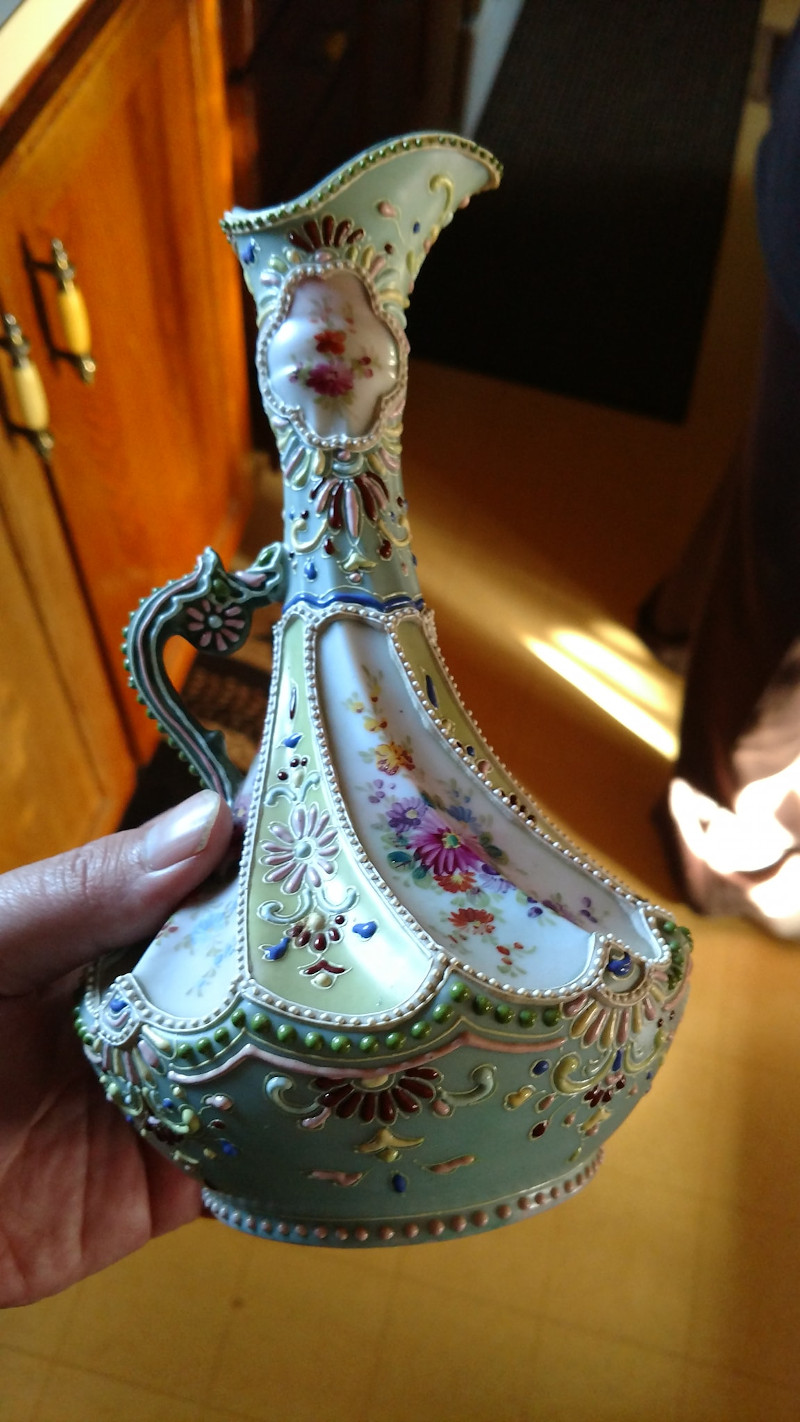
|
Subject:Re: Shimamura Sei - Floral Moriage Ewer
Posted By: Martin Michels Sat, Feb 19, 2022
Hi Jeff,
I found the Kyoto part of Shimamura on a Just-answer site, but unfortunately the link does not worj when copying it from here, so I copied the article underneath. I found the article googling with "shingo shimamura kyoto".
Regards,
Martin.
Antique Expert's response
11 Sep 2014
Robert S.
Thanks so much for the images, that helps a lot.
The artistry on this vase is completely pleasing. Two great scenic paintings, one side a prince shows his princess a pair of cranes, or tsuru, sacred symbols of peace, longevity and marital fidelity in the oriental tradition. Cranes were believed to live for a thousand years and mate for life. The second part of that is certainly true. On the other side of the vase, two arhats (Buddhist holy men) watch the heavenly dragon, ruler of thunder and rain, blow up a storm over the ocean.
Above them around the neck of the vase are detailed brocading and fan shaped reserves filled with tea ceremony objects on one side and scholar's objects on the other.
You are right about the material, this is fine white porcelain and this type of ceramic is known as "Satsuma style decorated porcelain" and was a speciality of Kyoto. In fact some of the best Satsuma style decoration was done in Kyoto in the late 19th and early 20th century. The undecorated porcelain blanks probably came from a kiln in Seto which was famous for the quality of its bright white porcelain clay.
The mark on the bottom does indeed say 日本京都 - 島村製 "Nippon Kyoto, Shimamura sei".
I would say this is almost certainly connected with the Shingo Shimamura you mentioned who came to the US as an importer/retailer of Japanese porcelain and other decorative goods. Not a lot is known about the Shimamura decorating shop in Kyoto [in fact there are virtually no surviving records for any of the ceramic decorating that was done for the export market]. It specialized in the mass production of export ware for which there was no domestic market in Japan, indeed most Japanese at the time were unaware of the style and extent of what was being manufactured for export. The studio was doubtless like the hundreds of others in Kyoto, little more than a sweat shop employing young paintresses with good eyesight and a steady hand, some of whom would have been no more than eight or nine years old. Here's a wonderful but telling old stereo photo taken in 1904 showing how these shops produced every conceivable type of Japanese ceramic decoration under one roof, from Kutani to Imari to Satsuma to moriage encrusted Nippon ware.
As you probably may know, Shingo Shimamura opened a store selling Japanese imports in Atlantic City, NJ in 1888. He was also an active participant at both the world trade fairs of Chicago in*****Louis in 1904 where he exhibited expertly made porcelain with lavish moriage slip decoration on eggshell porcelain that was particularly well received by the American public.
Looking at the hairstyle and the faces of the figures on your vase (quite a good way to date them as they were subject to the fashions of the day as much as anyone else) I would date this piece to the late Meiji, circa 1880 and no later than 1900.
As regards ***** ***** was obviously by an experienced and talented hand, but not being one of the top Satsuma 'names' it won't be worth big money, but it's a desirable piece nonetheless, and certainly a whole lot better than what was turned out in later years by those little paintress fingers. It would sell at a good antique auction house or on line in the range of $400 - $600. It therefore has a 'replacement' value of $1200 and is what you should insure it for.
I do hope this helps!
Please let me know if you would like me to expand or explain further, I would be glad to.
Best wishes,
Robert


|
 Shimamura Sei - Floral Moriage Ewer
Shimamura Sei - Floral Moriage Ewer  ( China & Japan ) - Jesse Krauss - Nov 26, 2019 (02:47 PM)
( China & Japan ) - Jesse Krauss - Nov 26, 2019 (02:47 PM)  Re: Shimamura Sei - Floral Moriage Ewer - I.Nagy - Nov 27, 2019 (05:08 AM)
Re: Shimamura Sei - Floral Moriage Ewer - I.Nagy - Nov 27, 2019 (05:08 AM)  Re: Shimamura Sei - Floral Moriage Ewer - Martin Michels - Nov 27, 2019 (05:48 AM)
Re: Shimamura Sei - Floral Moriage Ewer - Martin Michels - Nov 27, 2019 (05:48 AM)  Re: Shimamura Sei - Floral Moriage Ewer - Jeff - Feb 16, 2022 (05:42 AM)
Re: Shimamura Sei - Floral Moriage Ewer - Jeff - Feb 16, 2022 (05:42 AM)  Re: Shimamura Sei - Floral Moriage Ewer - Martin Michels - Feb 19, 2022 (08:29 AM)
Re: Shimamura Sei - Floral Moriage Ewer - Martin Michels - Feb 19, 2022 (08:29 AM)  Re: Shimamura Sei - Floral Moriage Ewer - Jeff - Feb 20, 2022 (01:49 AM)
Re: Shimamura Sei - Floral Moriage Ewer - Jeff - Feb 20, 2022 (01:49 AM) 
